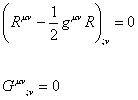

Guv = -(8[pi]G/c4)Tuv
This is Einstein�s gravitational field equation. G is the Universal Gravitational Constant. The force of attraction between two masses is F = Gm1m2/r2. G = 6.674215 x 10-11 m3/kgs2
The Riemann tensor in N dimensions has N4 components, but few are independent due to internal symmetries. For instance, for N = 2, there is only one independent component, the Gaussian curvature of the surface. This is R/2, where R = RuvRuv is the curvature scalar. In general relativity, the most important symmetry is the Bianchi identity which says the Einstein tensor is covariantly conserved.

(Ruv - (1/2)guvR);v = 0 or Guv;v = 0
The metric tensor also has zero covariant derivative.
guv;v = 0
This can be viewed as a statement of the equivalence principle, saying that inertial frames are those in which apparent gravitational forces can be transformed away.
This is Einstein�s gravitational field equation.

Guv = -(8[pi]G/c4)Tuv
However, you can add another term like this.

Guv + [lambda]guv= -(8[pi]G/c4)Tuv
Λ is the cosmological constant. The cosmological constant is an extra term in Einstein's equations of general relativity which physically represents the possibility that there is a density and pressure associated with "empty" space. If you get Tuv by itself on the left hand side, you have

Tuv = (/\c4/8[pi]G)guv
which represents the energy-momentum tensor of the vacuum. This means vacuum would exert negative pressure on the universe. Einstein invented it in 1917 to allow a steady state universe, and he rejected it when it was discovered that the Universe is expanding. The expansion from the Big Bang would prevent the Universe from collapsing.
When the Hubble telescope looked at distant supernovae, it was discovered that the expansion of the Universe was accelerating. This shows that we do have a cosmological constant or some other form of dark energy providing negative pressure to the Universe. There is a problem with using the cosmological constant to explain this. According to current theories, the predicted value of the cosmological constant is 120 orders of magnitude larger than the observed value.
In many theories, there are a large number of dimensions, not just the (3 + 1)-dimensional spacetime we see. In n dimensions, with n > 2, the number of independent components of the Riemann and Ricci tensors are as follows.

Riemann - n2(n2 - 1)/12
Ricci - n(n + 1)/2
The Riemann tensor can be decomposed in the following way.

R[alpha][beta][gamma][delta] = (1/(n � 2))(g[alpha][gamma]R[beta][delta] + g[beta][delta]R[alpha][gamma] - g[alpha][delta]R[beta][gamma] � g[beta][delta]R[alpha][delta]) � (R/((n � 1)(n � 2)))(g[alpha][gamma]g[beta][gamma] - g[alpha][gamma]g[beta][gamma]) � C[alpha][beta][gamma][delta]
The tensor Cαβγδ is the Weyl tensor and is zero for n < 4. The Ricci tensor says how any small freely falling ball of initially comoving test particles starts changing in volume. The Ricci tensor only captures some of the information in the Riemann curvature tensor. The rest is captured by the Weyl tensor, which says how any such ball starts changing in shape. The Weyl tensor describes tidal forces and gravitational waves.